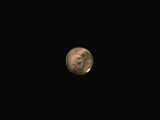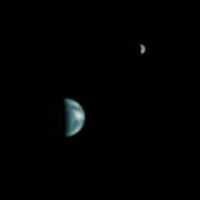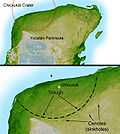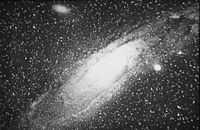Radiation astronomy/Objects
< Radiation astronomy
The science of radiation astronomy often focuses on natural objects in the sky about which physical and logical laws may be obtained. These radiation astronomy objects or radiation objects are found very close to our home on Earth and include the Earth itself and the Moon.
Initially looking as close to home as possible should uncover local objects that are sources of radiation in various forms.
The SIMBAD reference database "contains identifications, 'basic data', bibliography, and selected observational measurements for several million astronomical objects."[1]
"The specificity of the SIMBAD database is to organize the information per astronomical object".[1] "Building a reference database for ... all astronomical objects outside the Solar System – has been the first goal of the CDS".[1] "The only astronomical objects specifically excluded from SIMBAD are the Sun and Solar System bodies."[1]
As indicated in the learning resource astronomy, there are many objects between the observer on the ground atop some portion of the Earth's crust, astronomical objects such as the Sun and Solar System bodies, and those beyond the limits of the solar system. Further, for those observers looking toward the Earth from another location such as near the Moon, it seems that the Earth is a natural object.
Astronomical objects that radiate, reflect, or fluoresce may range in size from individual atoms or subatomic particles to rocky objects, gaseous objects, or plasma objects, including those that are composites.
Astronomical objects are likely to have a discrete form that separates them from the electromagnetic background.
Objects




Theoretical astronomy provides a definition (Def.) of an object in astronomy:
Def. a natural object in the sky especially at night is called an astronomical object.
A celestial object is any astronomical object except the Earth.
Some objects seem to wander around in the night sky relative to many of the visual points of light. At least one occasionally is present in the early morning before sunrise as the Morning Star and after sunset as the Evening Star, the planet Venus. These wanderers and related objects are subjects for observational astronomy and some are meteors.
Others only make an appearance after decades, sometimes spectacularly.
"The 1910 approach, which came into naked-eye view around 10 April[2] and came to perihelion on 20 April,[2] was notable for several reasons: it was the first approach of which photographs exist, and the first for which spectroscopic data were obtained.[3] Furthermore, the comet made a relatively close approach of 0.15AU,[2] making it a spectacular sight. Indeed, on 19 May, the Earth actually passed through the tail of the comet.[4][5] One of the substances discovered in the tail by spectroscopic analysis was the toxic gas cyanogen,[6] which led astronomer Camille Flammarion to claim that, when Earth passed through the tail, the gas "would impregnate the atmosphere and possibly snuff out all life on the planet."[7] His pronouncement led to panicked buying of gas masks and quack "anti-comet pills" and "anti-comet umbrellas" by the public.[8] In reality, as other astronomers were quick to point out, the gas is so diffuse that the world suffered no ill effects from the passage through the tail.[7]"[9]
"It is quite possible that [faint streamers preceding the main tail and lying nearly in the prolonged radius vector] may have touched the Earth, probably between May 19.0 and May 19.5, [1910,] but the Earth must have passed considerably to the south of the main portion of the tail [of Halley's comet]."[10]
Of the other planets of the solar system, Mercury, Mars, Jupiter, Saturn, Uranus, and Neptune, none has apparently produced as much drama and excitement recently on Earth among some of the intelligent life forms as Halley's comet.
According to the Wikipedia article on the planet Mars: "Mars made its closest approach to Earth and maximum apparent brightness in nearly 60,000 years, 55,758,006 km (0.372719 [Astronomical unit] AU), magnitude −2.88, on 27 August 2003 at 9:51:13 UT."
But asteroid impacts, though rare, occur once in a while, over very large areas, at aperiodic intervals such as the Chicxulub crater. Most scientists agree that this impact is the cause of the Cretatious-Tertiary Extinction, 65 million years ago (Ma), that marked the sudden extinction of the dinosaurs and the majority of life then on Earth. This shaded relief image of Mexico's Yucatan Peninsula shows a subtle, but unmistakable, indication of the Chicxulub impact crater.
Still much further away from the Earth than the Sun or Neptune are the many stars and nebulae that make up the Milky Way. Beyond the confines of our galaxy is the Andromeda Galaxy.
Of the Local Group, “[i]ts two dominant galaxies, the Milky Way and Andromeda (M31), are separated by a distance of ~700 kpc and are moving toward each other with a radial velocity of about -117 km s-1 (Binney & Tremaine 1987, p. 605).”[11] "making [Andromeda] one of the few blueshifted galaxies. The Andromeda Galaxy and the Milky Way are thus expected to collide in about 4.5 billion years, although the details are uncertain since Andromeda's tangential velocity with respect to the Milky Way is only known to within about a factor of two.[12] A likely outcome of the collision is that the galaxies will merge to form a giant elliptical galaxy.[13] Such events are frequent among the galaxies in galaxy groups. The fate of the Earth and the Solar System in the event of a collision are currently unknown. If the galaxies do not merge, there is a small chance that the Solar System could be ejected from the Milky Way or join Andromeda.[14]"[15]
The various objects and entities that are observed and studied that do not appear to cause us harm also engender separate areas within astronomy, some of which are
- Extragalactic astronomy,
- Galactic astronomy,
- Physical cosmology,
- Planetary science,
- Solar astronomy, and
- Stellar astronomy.
Neutrons
"[G]alactic (X-ray pulsars, binary systems - black hole candidates) and extragalactic (blasars) objects [emit] gamma-rays [in periodical processes] and high-energy neutral radiation (gamma-rays, neutrons) [is emitted from] solar flares."[16]
Positrons
"It is possible that the X-ray continuum is primary while the radio and optical emission are secondary for all BL Lac objects when the effect of relativistic beaming is considered. Pair production is a possible mechanism for producing X-ray emissions, while the optical and radio emission would be a consequence of this model (Zdziarski & Lightman 1985; Svensson 1986; Fabian et al. 1986). Barr & Mushotzky (1986) showed a significant correlation between the X-ray luminosity and timescale of X-ray variability for Seyfert galaxies and quasars and interpreted this as evidence that the emitting plasma is near the limit of being dominated by electron-positron pairs."[17]
Neutrinos
“[S]ince many neutrinos [are assumed to] come from stellar cores and supernovae, they are released at great temperature/energy. As neutrinos do not interact with matter electromagnetically, they are by definition dark matter.”[18]
Gamma rays
Over the entire celestial sphere, SIMBAD currently records 3253 gamma-ray objects. Some of these, like 4U 1705-44, are low-mass X-ray binaries (LMXBs). Some, like V779 Centauri, are high-mass X-ray binaries (HXMBs). Others are quasi-stellar objects (PKS 1326-697), supernova remnants (SNRs) like Messier 1 (M 1), and Seyfert galaxies like M 98. Some gamma-ray emitting objects have not been sufficiently resolved to determine what they are.
X-rays
Many astronomical objects when studied with visual astronomy may not appear to also be X-ray objects.
The SIMBAD database "contains identifications, 'basic data', bibliography, and selected observational measurements for several million astronomical objects."[1] Among these are some 209,612 astronomical X-ray objects. This information is found by going to the SIMBAD cite listed under 'External links', clicking on "Criteria query" and entering into the box "otype='X'", without the quotes, for an 'object count', and clicking on 'submit query'.
Ultraviolets
"A PG 1159 star, often also called a pre-degenerate,[19] is a star with a hydrogen-deficient atmosphere which is in transition between being the central star of a planetary nebula and being a hot white dwarf. These stars are hot, with surface temperatures between 75,000 K and 200,000 K,[20] and are characterized by atmospheres with little hydrogen and absorption lines for helium, carbon and oxygen. ... The PG 1159 stars are named after their prototype, PG 1159-035. This star, found in the Palomar-Green survey of ultraviolet-excess stellar objects,[21] was the first PG 1159 star discovered."[22]
Blues
The Edinburgh-Cape Blue Object Survey is an astronomical catalog included in the list of astronomical catalogues. These catalogs are lists or tabulations of astronomical objects. They are "grouped together because they share a common type, morphology, origin, means of detection, or method of discovery."[23]
Yellows
"An abundance analysis of the yellow symbiotic system AG Draconis reveals it to be a metal-poor K-giant ([Fe/H]=-1.3) which is enriched in the heavy s-process elements. ... the other yellow symbiotic stars are probably low-metallicity objects as well."[7]
Reds
"The nature of extremely red objects (EROs) remains an open question in understanding the faint galaxy population at z > 1."[24]
Submillimeters
"On the whole the emission strength is low in the submillimeter for astronomical objects."[25]
Moon
Science about the apparent rocky object in close proximity to the Earth has been accumulating perhaps since the beginning of oral traditions and written records. A number of intelligent species currently or formerly extant on Earth may have made such traditions and records.
Research
Hypothesis:
- Not all astronomical objects are detectable by radiation astronomy.
Control groups

The findings demonstrate a statistically systematic change from the status quo or the control group.
“In the design of experiments, treatments [or special properties or characteristics] are applied to [or observed in] experimental units in the treatment group(s).[26] In comparative experiments, members of the complementary group, the control group, receive either no treatment or a standard treatment.[27]"[28]
Proof of concept
Def. a “short and/or incomplete realization of a certain method or idea to demonstrate its feasibility"[29] is called a proof of concept.
Def. evidence that demonstrates that a concept is possible is called proof of concept.
The proof-of-concept structure consists of
- background,
- procedures,
- findings, and
- interpretation.[30]
See also
References
- 1 2 3 4 5 Marc Wenger, François Ochsenbein, Daniel Egret, Pascal Dubois, François Bonnarel, Suzanne Borde, Françoise Genova, Gérard Jasniewicz, Suzanne Laloë, Soizick Lesteven, and Richard Monier (April 2000). "The SIMBAD astronomical database The CDS Reference Database for Astronomical Objects". Astronomy and Astrophysics 143 (4): 9-22. doi:10.1051/aas:2000332.
- 1 2 3 D. K. Yeomans (1998). "Great Comets in History". Jet Propulsion Laboratory. Retrieved 15 March 2007.
- ↑ D. A. Mendis (1988). "A Postencounter view of comets". Annual Review of Astronomy and Astrophysics 26 (1): 11–49. doi:10.1146/annurev.aa.26.090188.000303.
- ↑ Ian Ridpath (1985). "Through the comet’s tail". Revised extracts from A Comet Called Halley by Ian Ridpath, published by Cambridge University Press in 1985. Retrieved 2011-06-19.
- ↑ Brian Nunnally (May 16, 2011). "This Week in Science History: Halley’s Comet". pfizer: ThinkScience Now. Retrieved 2011-06-19.
- ↑ "Yerkes Observatory Finds Cyanogen in Spectrum of Halley's Comet". The New York Times. 8 February 1910. Retrieved 15 November 2009.
- 1 2 3 "Ten Notable Apocalypses That (Obviously) Didn't Happen". Smithsonian magazine. 2009. Retrieved 14 November 2009.
- ↑ "Interesting Facts About Comets". Universe Today. 2009. Retrieved 15 January 2009.
- ↑ "Halley's Comet, In: Wikipedia". San Francisco, California: Wikimedia Foundation, Inc. September 18, 2012. Retrieved 2012-09-19.
- ↑ Heber D. Curtis (June 1910). "Photographs of Halley's Comet made at the Lick Observatory". Publications of the Astronomical Society of the Pacific 22 (132): 117-30.
- ↑ Abraham Loeb, Mark J. Reid, Andreas Brunthaler, and Heino Falcke (November 2005). "Constraints on the Proper Motion of the Andromeda Galaxy Based on the Survival of Its Satellite M33". The Astrophysical Journal 633 (2): 894-8. doi:10.1086/491644. http://iopscience.iop.org/0004-637X/633/2/894/fulltext. Retrieved 2011-11-14.
- ↑ The Grand Collision, from the series: The Sky At Night, airdate: November 5, 2007
- ↑ Cox, T. J.; Loeb, A. (2008). "The collision between the Milky Way and Andromeda". Monthly Notices of the Royal Astronomical Society 386 (1): 461–474. doi:10.1111/j.1365-2966.2008.13048.x.
- ↑ Cain, F. (2007). "When Our Galaxy Smashes Into Andromeda, What Happens to the Sun?". Universe Today. Retrieved 2007-05-16.
- ↑ "Andromeda Galaxy, In: Wikipedia". San Francisco, California: Wikimedia Foundation, Inc. September 20, 2013. Retrieved 2013-09-26.
- ↑ Kudryavtsev M. I., Pankov V. M., Bogomolov A. V., Bogomolov V. V., Denisov Yu. I., Kolesov G. Ya., Logachev Yu. I., Svertilov S. I. (1995). N. Iucci and E. Lamanna. ed. The MIR-SPECTR Gamma-Astronomy Experiment. 3. Rome, Italy: International Union of Pure and Applied Physics. pp. 567-70. http://adsabs.harvard.edu/abs/1995ICRC....3..567K. Retrieved 2013-11-01.
- ↑ G. Z. Xie, B. F. Liu, and J. C. Wang (November 20, 1995). "A Signature of Relativistic Electron-Positron Beams in BL Lacertae Objects". The Astrophysical Journal 454 (11): 50-4. doi:10.1086/176463. http://adsabs.harvard.edu/full/1995ApJ...454...50X. Retrieved 2013-08-13.
- ↑ "Neutrino astronomy, In: Wikipedia". San Francisco, California: Wikimedia Foundation, Inc. March 5, 2012. Retrieved 2012-06-08.
- ↑ Jaschek & Jaschek: CARBON C
- ↑ Observational constraints on the evolutionary connection between PG 1159 stars and DO white dwarfs, S. D. Huegelmeyer, S. Dreizler, K. Werner, J. Krzesinski, A. Nitta, and S. J. Kleinman. arXiv:astro-ph/0610746.
- ↑ The Palomar-Green catalog of ultraviolet-excess stellar objects, R. F. Green, M. Schmidt, and J. Liebert, Astrophysical Journal Supplement 61 (June 1986), pp. 305–352. Centre de Données astronomiques de Strasbourg (CDS) ID II/207.
- ↑ "PG 1159 star, In: Wikipedia". San Francisco, California: Wikimedia Foundation, Inc. April 15, 2013. Retrieved 2013-07-02.
- ↑ "List of astronomical catalogues, In: Wikipedia". San Francisco, California: Wikimedia Foundation, Inc. May 19, 2013. Retrieved 2013-05-30.
- ↑ Michael C. Liu, Arjun Dey, James R. Graham, Charles C. Steidel and Kurt Adelberger (1999). Andrew J. Bunker and Wil J. M. van Breugel. ed. Extremely Red Galaxies in the Field of QSO 1213-0017: A Galaxy Concentration at z = 1.31, In: The Hy-Redshift Universe: Galaxy Formation and Evolution at High Redshift. 193. Berkeley, California USA: American Society of Physics. pp. 344-7. ISBN 1-58381-019-6. Bibcode: 1999ASPC..193..344L. http://adsabs.harvard.edu/full/1999ASPC..193..344L. Retrieved 2013-07-30.
- ↑ T.G. Phillips, J. Keene (November 1992). "Submillimeter astronomy [heterodyne spectroscopy"]. Proceedings of the IEEE 80 (11): 1662-78. doi:10.1109/5.175248. http://ieeexplore.ieee.org/xpls/abs_all.jsp?arnumber=175248. Retrieved 2013-10-21.
- ↑ Klaus Hinkelmann, Oscar Kempthorne (2008). Design and Analysis of Experiments, Volume I: Introduction to Experimental Design (2nd ed.). Wiley. ISBN 978-0-471-72756-9. http://books.google.com/?id=T3wWj2kVYZgC&printsec=frontcover.
- ↑ R. A. Bailey (2008). Design of comparative experiments. Cambridge University Press. ISBN 978-0-521-68357-9. http://www.cambridge.org/uk/catalogue/catalogue.asp?isbn=9780521683579.
- ↑ "Treatment and control groups, In: Wikipedia". San Francisco, California: Wikimedia Foundation, Inc. May 18, 2012. Retrieved 2012-05-31.
- ↑ "proof of concept, In: Wiktionary". San Francisco, California: Wikimedia Foundation, Inc. November 10, 2012. Retrieved 2013-01-13.
- ↑ Ginger Lehrman and Ian B Hogue, Sarah Palmer, Cheryl Jennings, Celsa A Spina, Ann Wiegand, Alan L Landay, Robert W Coombs, Douglas D Richman, John W Mellors, John M Coffin, Ronald J Bosch, David M Margolis (August 13, 2005). "Depletion of latent HIV-1 infection in vivo: a proof-of-concept study". Lancet 366 (9485): 549-55. doi:10.1016/S0140-6736(05)67098-5. http://www.ncbi.nlm.nih.gov/pmc/articles/PMC1894952/. Retrieved 2012-05-09.
External links
- African Journals Online
- Bing Advanced search
- Google Books
- Google scholar Advanced Scholar Search
- International Astronomical Union
- JSTOR
- Lycos search
- NASA/IPAC Extragalactic Database - NED
- NASA's National Space Science Data Center
- NCBI All Databases Search
- Office of Scientific & Technical Information
- PubChem Public Chemical Database
- Questia - The Online Library of Books and Journals
- SAGE journals online
- The SAO/NASA Astrophysics Data System
- Scirus for scientific information only advanced search
- SDSS Quick Look tool: SkyServer
- SIMBAD Astronomical Database
- SIMBAD Web interface, Harvard alternate
- Spacecraft Query at NASA.
- SpringerLink
- Taylor & Francis Online
- Universal coordinate converter
- WikiDoc The Living Textbook of Medicine
- Wiley Online Library Advanced Search
- Yahoo Advanced Web Search
| |||||||||||||||||||||||||||||||||||
| ||||||||||||||||||||||||||||||||
| ||||||||||||||||||||||||||||||||||||||
| |||||||||||||||||||||||||||||||||||
![]() This is a research project at http://en.wikiversity.org
This is a research project at http://en.wikiversity.org
| |
Development status: this resource is experimental in nature. |
| |
Educational level: this is a research resource. |
| |
Resource type: this resource is an article. |
| |
Resource type: this resource contains a lecture or lecture notes. |
| |
Subject classification: this is an astronomy resource. |